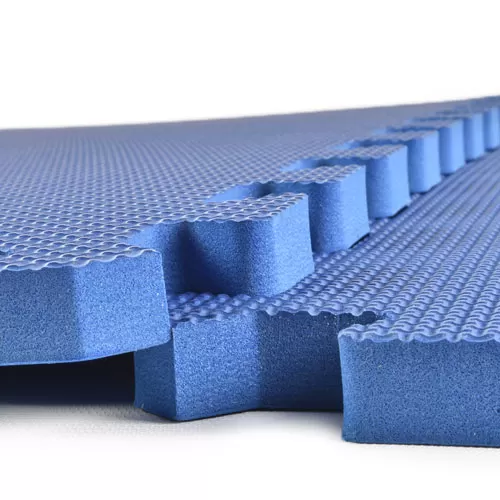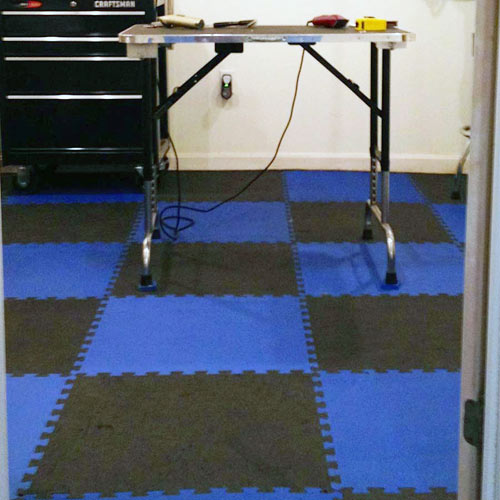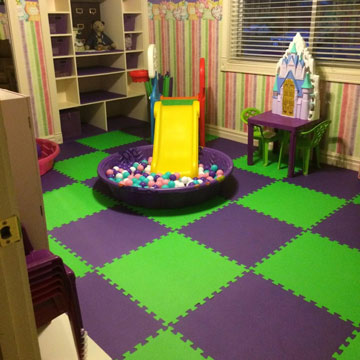How to Keep Foam Mats Together Without Buckling
Foam flooring tiles are very easy to install, which is just one of the many benefits that this type of flooring offers. Interlocking foam tiles fit together like puzzle pieces, and can be installed on any hard, flat surface. However, there's one step that people sometimes overlook during installation, and that's why foam floor buckling may become an issue.
What You Need to Know About EVA Foam Expansion

At Greatmats, we offer a wide selection of foam tiles that we've chosen according to their quality and performance. Most of these tiles are made of Ethylene-Vinyl Acetate, also known as EVA. EVA foam is a closed-cell foam. This is the type of foam that is often used in sports flooring and equipment, because it offers excellent shock absorption. It's durable, comfortable, and makes for a safe flooring tile.
 Another major advantage of EVA foam is that it's both waterproof and non-absorbent. This means that you can use foam tiles in many different ways, in many different locations. Because the tiles won't be damaged by water, you can use them in basements even if leaks or moisture may be an issue. And cleaning up spills in kids' play spaces is a breeze, because the tiles won't absorb a spilled drink.
Another major advantage of EVA foam is that it's both waterproof and non-absorbent. This means that you can use foam tiles in many different ways, in many different locations. Because the tiles won't be damaged by water, you can use them in basements even if leaks or moisture may be an issue. And cleaning up spills in kids' play spaces is a breeze, because the tiles won't absorb a spilled drink.
If you pick up any of these foam tiles, you'll quickly discover that EVA foam is also lightweight. The tiles are light and easy to carry, so they're portable, and a single person can install them. Though the tiles are lightweight, they're soft and cushioned, and some even offer anti-fatigue properties that help to keep you comfortable.
EVA foam offers many benefits that make it ideal for use in flooring tiles. However, one downside to the foam is the fact that it's somewhat temperature-sensitive, and expands and contracts with temperature fluctuations. The contraction as temperatures drop doesn't tend to be an issue, but when temperatures increase, the foam tiles expand.
It is this expansion that can lead to foam floor buckling. If the flat foam flooring has been installed in a wall-to-wall fashion, where the flooring presses up against each wall, the foam flooring expansion may cause tiles in the middle of the floor to buckle up, creating an uneven area.
The problem won't be permanent, and will resolve once the temperature drops and the EVA foam expansion is reversed. But you can also solve this foam floor buckling issue by following the installation steps below.
What To Know About Installing Foam Flooring
When you're installing foam flooring, whether you're working with EVA tiles or rollout cross-linked polyethylene foam flooring, you need to leave room for the product to expand. This means that you'll always need to leave a little bit of a gap between the edge of your flooring and surrounding walls or other objects.
For a wall-to-wall installation, start in one corner of your room, and position the tiles so there's a gap of at least 1/4 inch between the tiles and the walls. If you live in an area with high heat and humidity - or you use in-floor heating - plan on allowing additional room for expansion. Then, work your way out into the room, piecing the tiles together like puzzle pieces as you go.
When you reach the opposite walls, you will likely need to cut your tiles to fit. This is a simple process, because foam tiles can be cut with a sharp utility knife and a straight edge. Measure the remaining space between the last tile and the wall, accommodating for a 1/4-inch-plus gap between the tile and the wall. Then, using a straight edge as a guide, cut each tile to fit. We recommend that you run your utility knife along the straight edge to make repeated, shallow scores. If the utility knife starts to pull up or shred pieces of the tile, then it's time to replace your blade.
Once you've cut the last of your tiles, you can finish the installation.
Island installations are a bit simpler, since you're not working between walls. Many of our tiles are available with border pieces, which create a clean, finished edge. Position the tiles in the room, fit the tiles together, and install your border pieces. There's no concern about EVA foam expansion when you're performing an island installation, since the tiles will have plenty of room to expand and contract. Foam floor expansion will occur, but you won't see the floor buckling or curling up.
Solving Foam Floor Expansion After an Installation
If foam floor buckling becomes an issue only after you've installed the floor, you may need to partially uninstall the floor to correct the issue. Your floor will buckle when you haven't left enough space between the tiles and the surrounding walls.Start by removing the tiles that travel along one wall. You may need to cut these tiles using the method described above, so that they're small enough to allow for a gap. If possible, you may be able to slide your whole floor out from the opposite walls just a bit to allow for an adequate gap. If your floor is large, you may need to take more of the tiles apart to allow for adjustment and movement.
This is one of the benefits of working with tiles - if you find that you need to remove or alter the flooring, you can pull up the tiles and reposition them. Once you've altered the floor so that there's enough room for the foam to expand, the buckling won't be an issue in the future.
How to Keep Foam Mats Together

With good-quality interlocking foam puzzle mats, keeping them together is rarely the problem. Much of this is determined by a combination of the firmness of the foam and its thickness. If you have a softer foam, you'll be better served by going a bit thicker so the interlocks don't give way. Greatmats interlocking foam mats are designed with a firmness that will hold at any of its offered thicknesses, assuming the flooring is installed over a hard, flat surface.
With that being said, although most foam flooring is pretty pliable and can conform to somewhat uneven surfaces, it is still recommended that they be installed over hard and flat subsurfaces. Irregularities or significant height changes in the subflooring can cause the interlocks of puzzle-style foam floors to weaken and possibly separate, especially if that height change occurs under a seam. The changes can occur from something as simple as cracking and heaving concrete basement floors.
If your foam flooring comes in a roll-out form, keeping the mats together generally requires an accessory of sorts. In some cases, the mats can be secured to the subfloor with double-sided tape to keep them from shifting or sliding apart. But in most cases, you'll want to attach the mats together at the surface using tape or connector strips. Vinyl-topped foam roll out mats can be held together using tape. If the foam mats have a carpet top, you'll want to use the hook-and-loop connector strip at the seams.
Gluing foam play mats or other foam flooring together is generally not advised.
Choosing the Right Foam Flooring

Foam flooring does expand, but it's a problem that's easily avoided with a proper and deliberate installation. However, for that one potential downside, foam flooring offers many benefits that make it a popular choice for homes, trade shows, and even workplace flooring.
Are you looking for a flooring solution for a new project? Foam flooring offers many benefits, including:
- Comfort - Foam makes a comfortable, forgiving surface. It's forgiving properties can be beneficial for anything from anti-fatigue impact absorption. It's no wonder that foam tiles are so popular for trade show booth flooring, where people spend hours on their feet.
Additionally, foam helps to provide some thermal buffering, keeping the cold of a concrete floor from working its way up into the flooring. This property means that you can use foam to quickly and easily convert an unwelcoming floor into one that's comfortable to walk on with bare feet.
- Ease of Installation - Don't want to hire a professional to come install your flooring? With foam tiles, you don't have to. Most tiles can be installed directly on a hard, flat surface without the need for any adhesive. It's a project that you can do yourself, and if you need to remove the tiles in the future, you can pull them up and reinstall them again.
- Durability - Foam may be soft, but it's also highly durable. We offer a range of products that are comfortable to stand on, but which are constructed to withstand high traffic, such as those intended for use in trade shows.
- Versatility - Looking for an all-around product that can be used in multiple rooms in your home? Foam flooring fits the bill. Foam can make the perfect kids' play area flooring, but it's also a great choice for use in a basement, where moisture may be a concern. Turn an unused space into a welcoming room suitable for your family, or make a workspace more comfortable by using foam flooring.
- Low-Maintenance - With foam flooring, there's virtually no maintenance needed. You can clean foam tiles with a vacuum, and can damp mop when necessary for a deeper clean. You can also spot clean foam with a sponge. If you'd like, you can even pull up the tiles, take them outside, and clean them. Once the tiles have dried, you can bring them back indoors and reinstall them.
No matter how you decide to use your foam flooring, we're sure you'll be pleased with the products that you buy from Greatmats. We've carefully chosen the products we offer to provide you with quality, affordability, and excellent construction.
If you have questions, would like a product sample, or need a shipping quote, please contact our customer service team. We'd be happy to help you, and can even provide advice on choosing the right flooring product for your needs.














